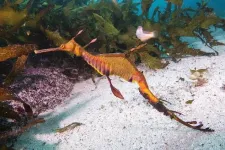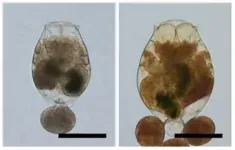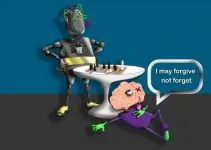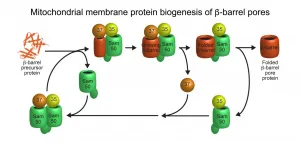Are partially protected areas the 'red herrings' of marine conservation?
2021-01-15
(Press-News.org) Partially protected areas - marine reserves that allow some forms of fishing - are no more effective socially or ecologically than open marine areas in Australia's Great Southern Reef, a new UNSW study has concluded.
The research, published in Conservation Biology today, comes at a time when the High Ambition Coalition of 50 countries of the world (which does not include Australia) have pledged to protect more than 30 per cent of the planet's lands and seas by the end of this decade. But not all protected areas are created equal.
The UNSW study discovered partially protected areas in southern Australia had no more fish, invertebrates or algae and no difference in the mix of users - and they were not valued any more highly by users than areas outside reserves (open areas).
The social and ecological researchers found fully protected areas (no-take or sanctuary zones), by comparison, had more fish, higher biodiversity of marine life and were an attraction to many coastal users both for their ecological and protection values.
Lead author John Turnbull, UNSW Science researcher, said partially protected areas appear to be the "red herrings" of marine conservation as they distract us from achieving more effective protection.
"Marine protected areas are the umbrella term for managed marine areas and can be fully or partially protected. They are a primary tool for the stewardship, conservation and restoration of marine ecosystems but globally, 69 per cent of marine protected areas are open to some form of fishing," Mr Turnbull said.
"This is a surprise to many people - almost half of the people we surveyed in partially protected areas (42 per cent) mistakenly thought they were in a reserve that protected fish.
"Just 12 per cent of people knew they were in a partially protected area, compared to 79 per cent of people in fully protected areas who correctly identified they were in one.
"This is not a small issue; three-quarters of Australia's marine protected area is open to fishing. Most partially protected areas in Australia even allow commercial fishing, which, on an industrial scale, is contrary to international ("IUCN" - International Union for Conservation of Nature) guidelines."
Australia's Great Southern Reef surveyed
The UNSW study spanned 7000km of coast and five states. The authors assessed 19 fully protected areas, 18 partially protected areas and 19 open areas. They each had different rules and marine communities but they all had broadly stated goals, such as the conservation of biodiversity and ecosystem integrity.
The researchers conducted 439 interviews and 190 observation surveys to gauge the social impact of each area (human use, perceptions and values), and analysed existing data from 625 underwater visual census Reef Life Surveys to determine the ecological impact of protection on marine communities (fish, invertebrates and algae).
Mr Turnbull said the research team found no social or ecological benefits for partially protected areas relative to open areas. For example, the ecological data revealed that fish species richness and biomass were higher in fully protected areas, but not in partially protected areas. There were 1.3x more fish species, 2.5x more fish biomass and 3.5x more large (20+ cm) fish biomass in fully protected areas compared to open areas.
Mr Turnbull said: "Global studies support our findings: there is a lot of research that shows a reduced, if any, impact of partial protection and it depends on the strength of that partial protection.
"Despite this, fully protected areas are often a very small percentage of a marine park; for example, Sydney's recently proposed marine park had less than three per cent designated as fully protected sanctuary zone, meaning 97 per cent of the area would be open to fishing if the park was approved. This is the degree of 'red herring' we are experiencing."
Fully protected areas more valued
Mr Turnbull said their research also busted the myth that fully protected areas were unpopular.
"On the contrary, 92 per cent of people we surveyed said they supported protected areas that restrict fishing. We believe our research reflects the general views of coastal users, because we designed our sampling to represent all the different types of user at each site; people swimming, walking, diving, fishing and so on.
"And there was virtually no difference in support for protected areas between people who fish and people who don't - just one per cent."
Mr Turnbull said the researchers also found most people were passionate about their local coastal areas.
"People want to see their area looked after and properly protected, especially with sanctuary zones. Often, people specifically visited these because they knew the area was fully protected, and they had personally observed the improvement in marine life" he said.
"In fully protected areas, we found a higher number of certain types of users; twice as many divers and over three times as many snorkelers. This showed people were directly experiencing the values of fully protected areas and acknowledged them and were attracted to them. This was not the case for partially protected areas; the mix and number of users in these areas were no different to open areas."
'Investment' should have a return
Study co-author and UNSW Dean of Science Professor Emma Johnston said if governments were going to allocate conservation resources to protect marine areas, they needed to be sure the "investment" was paying off.
"The current trend towards downgrading fully protected areas to partially protected areas in many parts of the world, including Australia, may be wasting precious conservation resources. Partially protected areas could still be useful but only for specific purposes; for example, to support traditional management practices, protect a particular threatened species, or to create a buffer zone for a fully protected area," Prof. Johnston said.
"But the results of our substantial study suggest that partially protected areas may be overused and represent a distraction from true conservation measures. The public are confused by partially protected areas and the general biodiversity is no better off."
Prof. Johnston said she hoped the researchers' findings would encourage decisionmakers to consider whether their conservation approach was fit for purpose.
"If we are going to truly protect our planet, partially protected areas must be monitored regularly and the results made public, because if they are failing to provide social or ecological returns, those areas should be upgraded to the level of protection that we know works," she said.
INFORMATION:
Find the study in Conservation Biology: https://conbio.onlinelibrary.wiley.com/doi/full/10.1111/cobi.13677
[Attachments] See images for this press release:

ELSE PRESS RELEASES FROM THIS DATE:
2021-01-15
Researchers from Kumamoto University (Japan) have found an Edo period document that clearly indicates the Hosokawa clan, rulers of the Kokura Domain (modern-day Fukuoka Prefecture), completely stopped producing wine in 1632, the year before the shogunate ordered them to move to the Higo Domain (now Kumamoto Prefecture). The researchers believe that the discontinuation of wine production was directly related to this move and because it was considered to be a drink of a religion that was harshly suppressed in Japan at that time, Christianity.
Previous analysis of historical documents revealed that the lord of the Hosokawa clan, Tadatoshi Hosokawa, ordered wine production from 1627 to 1630 for medicinal use. His ...
2021-01-15
Divergences between scientific and Indigenous and Local Knowledge can provide a better understanding of why local pastoralists may be willing, or not, to participate in conservation initiatives for carnivores, a study from University of Helsinki suggests.
Carnivore conservation has historically been based primarily on scientific knowledge using a wide range of sampling methods, such as camera trapping and track surveys. However, the estimates of these common ecological sampling methods can be quite uncertain and can depend on accessibility and geology, which is the case of many remote areas, such as Sibiloi National Park in Northern Kenya. For this reason, the inclusion of local communities that share ...
2021-01-15
A research team led by scientists at the RIKEN Nishina Center for Accelerator-Based Science (RNC) has successfully created larger-than-usual strains of zooplankton -- which are used in fish nurseries -- by creating mutations with a heavy ion beam. The new strains of zooplankton could contribute to improving the survival rate and optimizing the growth of juvenile fish in aquaculture.
Economically important fish species, such as bluefin tuna, yellowtail, flatfish and groupers, are fed live bait until they are large enough to be fed with artificial foods. ...
2021-01-15
Any building project requires the formulation of a series of initial plans prior to starting construction to serve as a basis and guide for the whole process. A similar procedure is followed in software development, with the inclusion of a specific step known as modelling. "The process is equivalent to the production of a set of plans for a building before its construction," explained Universitat Oberta de Catalunya (UOC) Faculty of Computer Science, Multimedia and Telecommunications professor and member of the SOM Research Lab research group -from the Internet Interdisciplinary Institute (IN3)-, Robert Clarisó.
Engineers use modelling to describe ...
2021-01-15
In the last decades, Artificial Intelligence has shown to be very good at achieving exceptional goals in several fields. Chess is one of them: in 1996, for the first time, the computer Deep Blue beat a human player, chess champion Garry Kasparov. A new piece of research shows now that the brain strategy for storing memories may lead to imperfect memories, but in turn, allows it to store more memories, and with less hassle than AI. The new study, carried out by SISSA scientists in collaboration with Kavli Institute for Systems Neuroscience & Centre for Neural Computation, Trondheim, Norway, has just been published in Physical Review Letters.
Neural networks, real or artificial, learn by tweaking the connections ...
2021-01-15
An innovative new study is set to examine if changing our mealtimes to earlier or later in the day could reduce the risk of developing Type 2 diabetes.
Led by Dr Denise Robertson, Professor Jonathan Johnston and post graduate researcher Shantel Lynch from the University of Surrey, the study, outlined in the journal Nutrition Bulletin, will investigate if changing the time we eat during the day could reduce risk factors such as obesity and cholesterol levels that are typically associated with the development of Type 2 diabetes. The team of researchers will also for the first time investigate, via a series of interviews with participants and their friends and family, the impact of such changes on home life, work/social commitments and whether co-habitants of those who make such ...
2021-01-15
Having genitals of a certain shape and size gives male flies a major reproductive advantage, new research shows.
University of Exeter scientists examined the reproductive success of male Drosophila simulans flies both alone with a female and in various states of competition with other males.
Certain genital shapes were consistently better in terms of number of offspring sired.
However - surprisingly, given how fast genital form evolves - the selection documented was rather weak.
"Male genitals generally, and in Drosophila specifically, evolve very quickly, so we were really surprised to find this weak selection," said Professor David Hosken, of the University of Exeter.
"Selection is the major mechanism of evolution and hence where we see rapid evolution, ...
2021-01-15
Mitochondria are vital for the human body as cellular powerhouses: They possess more than 1,000 different proteins, required for many central metabolic pathways. Disfunction of these lead to severe diseases, especially of the nervous system and the heart. In order to transport proteins and metabolites, mitochondria contain a special group of so-called beta-barrel membrane proteins, which form transport pores in the outer mitochondrial membrane. So far, scientists have not been able to explain the operating mode of the sorting and assembly machinery (SAM) for the biogenesis of these beta-barrel proteins. A team led by Prof. Dr. Toshiya Endo from Kyoto University/Japan, Prof. Dr. Nils Wiedemann and ...
2021-01-15
Guangzhou, January 15, 2021: New journal BIO Integration (BIOI) publishes its fourth issue, volume 1, issue 4. BIOI is a peer-reviewed, open access, international journal, which is dedicated to spreading multidisciplinary views driving the advancement of modern medicine. Aimed at bridging the gap between the laboratory, clinic, and biotechnology industries, it will offer a cross-disciplinary platform devoted to communicating advances in the biomedical research field and offering insights into different areas of life science, in order to encourage cooperation and exchange among scientists, clinical researchers, and health care providers.
The issue contains an original article, three review ...
2021-01-15
A clinical trial involving COVID-19 patients hospitalized at UT Health San Antonio and University Health, among roughly 100 sites globally, found that a combination of the drugs baricitinib and remdesivir reduced time to recovery, according to results published Dec. 11 in the New England Journal of Medicine. Six researchers from UT Health San Antonio and University Health are coauthors of the publication because of the San Antonio site's sizable patient enrollment in the trial.
The Adaptive COVID-19 Treatment Trial 2 (ACTT-2), which compared the combination therapy versus remdesivir paired with an inactive placebo in hospitalized COVID-19 patients, was supported by the National Institute of Allergy and Infectious Diseases (NIAID), ...
LAST 30 PRESS RELEASES:
[Press-News.org] Are partially protected areas the 'red herrings' of marine conservation?





